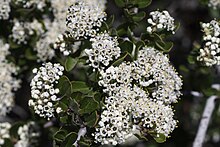| Ceanothus cuneatus | |
|---|---|

| |
|
Scientific classification
| |
| Kingdom: | Plantae |
| Clade: | Tracheophytes |
| Clade: | Angiosperms |
| Clade: | Eudicots |
| Clade: | Rosids |
| Order: | Rosales |
| Family: | Rhamnaceae |
| Genus: | Ceanothus |
| Species: | C. cuneatus
|
| Binomial name | |
| Ceanothus cuneatus | |
Ceanothus cuneatus is a species of flowering shrub known by the common names buckbrush and wedgeleaf ceanothus.
Distribution
This Ceanothus is native to Oregon, California, and northern Baja California, where it can be found in a number of habitats, especially chaparral.
Description

Ceanothus cuneatus is a spreading bush, rounded to sprawling, reaching up to 3 meters (9.8 ft) in height. The evergreen leaves are stiff and somewhat tough and may be slightly toothed along the edges. The bush flowers abundantly in short, thick-stalked racemes bearing rounded bunches of tiny flowers, each about half a centimeter wide.
The fragrant flowers are white, sometimes tinted strongly with blue or lavender. The fruit is a round capsule with horns. It is about half a centimeter wide and contains three shiny dark seeds which are dispersed when the capsule explodes and propels them some distance. Harvester ants have been known to catch the seeds, which can lie dormant for a long time since fire is required for germination. This plant may be variable in appearance because it hybridizes easily with similar species.
While this shrub has a wide distribution in its range, certain varieties of the species are limited to small areas. The Monterey ceanothus (var. rigida), for example, is found only between the southern edge of the San Francisco Bay Area and San Luis Obispo County.
Ecology
It is a larval host to the California hairstreak, California tortoiseshell, ceanothus silkmoth, echo blue, hedgerow hairstreak, Pacuvius duskywing, western green hairstreak, and white-streaked saturnia moth. [1]
References
- ^ The Xerces Society (2016), Gardening for Butterflies: How You Can Attract and Protect Beautiful, Beneficial Insects, Timber Press.
External links
-
 Media related to
Ceanothus cuneatus at Wikimedia Commons
Media related to
Ceanothus cuneatus at Wikimedia Commons - Calflora Database: Ceanothus cuneatus (Buck brush, Wedgeleaf ceanothus)
- USDA Plants Profile for Ceanothus cuneatus (buckbrush)
- USFS.gov: Ecology of Ceanothus cuneatus
- Ceanothus
- Flora of California
- Flora of Baja California
- Flora of Oregon
- Flora of the Cascade Range
- Flora of the Klamath Mountains
- Flora of the Sierra Nevada (United States)
- Natural history of the California chaparral and woodlands
- Natural history of the California Coast Ranges
- Natural history of the Peninsular Ranges
- Natural history of the San Francisco Bay Area
- Natural history of the Santa Monica Mountains
- Natural history of the Transverse Ranges
- Plants described in 1838
- Taxa named by Thomas Nuttall
- Butterfly food plants
- Rhamnaceae stubs